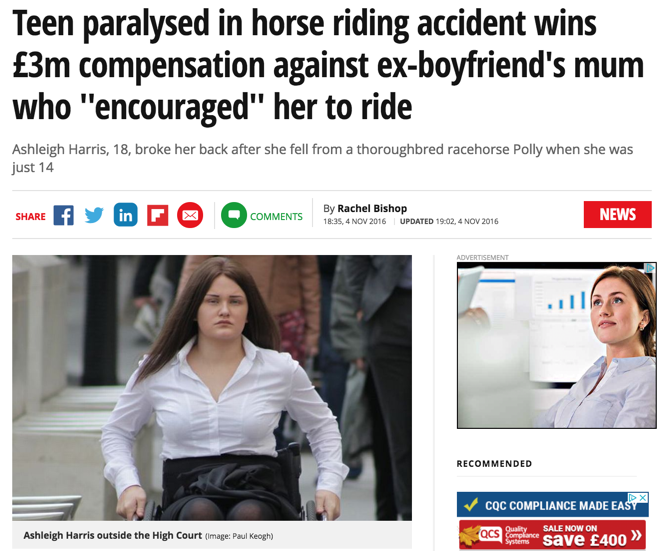A Horse Owner Faces £3m Bill For Accident That Left a Teenage Girl Seriously Injured
Ashleigh Harris is a teenager who after being been left paralysed in a tragic riding accident is set to receive more than £3million compensation after winning a High Court case against her ex-boyfriend’s mother.
Miss Harris had just turned 14 when she broke her back after falling from a horse that described as a ‘thoroughbred racehorse’ after she had been ‘encouraged to ride the ‘strong and willful thoroughbred’ and thus being exposed to a risk of injury.
The judge also said that Mrs Miller (the horse’s owner) had ‘limited knowledge’ of Ashleigh’s riding experience, and although the teenager was a ‘competent novice’, who had a lot of experience riding ponies, she had never ridden a horse before.
The judge, ruling in Ashleigh’s favour, he added: ‘By positively encouraging Ashleigh to ride the horse, and condoning, if not specifically instructing a trot in an open field for the first time, Mrs Miller was exposing her to a risk of injury from a horse which could not be controlled in other than the most benign of conditions.
What Can We Learn From This?
So as Physical Intervention and Self-Defence Instructors what can we learn from the ruling in this case?
1. Any trainer (PI or Self Defence) must be a competent trainer. That means having the qualification, knowledge and experience to teach and train people to the required competent level.
2. All risks must be identified and managed by a competent process of risk assessment.
3. Courses must be run with ’suitable’ and ’sufficient’ supervision. Suitable means that are all relevant and appropriate measures being taken to manage them, and ‘sufficient’ means taking into account best practice and having ‘sufficient’ numbers of ‘suitably qualified’ and competent trainers in place to manage the risk of training a group of people and having the skills to control any foreseeable or likely risky behaviour.
So let me tell you some of the questions I get asked on a frequent basis (and these are real examples of the questions I get asked) and I’ll leave you to work out the answers. Here’s my Top 10:
1. “My company has asked me to deliver a physical intervention training course to twenty staff on my own. Who is responsible if someone gets hurt. Me or my organisation for putting me in that position?”
2. “I have just turned up to run a physical intervention course with sixty learners attending. I and one other were the only qualified trainers there. The other trainers who turned up to assist had no trainer qualifications, had never taught a physical intervention course before and their only experience was that they had attended the course we were teaching once or twice before as delegates.”
3. “I turned up to run a self-defence course and there were twelve people on it. The room was really small and there were tables and chairs everywhere. In the room, some of the tables and chairs had been stacked on top of each other and the carpet was lifting in some areas.”
4. “Some people attending the course had turned up in croc’s (slip-on shoes), sandals and shoes with heels. I advised them that their footwear was inappropriate but they said that those were the types of shoes they wear for work and they are expected to restrain violent and aggressive service users at work in them.”
5. “The skills being taught just don’t work and staff are getting injured all the time, but the LEA say we have to use this system because it is the one they have signed up to.”
6. “You have just shown us a technique that has been advised not to be used. We were taught that technique less than three months ago by our current training provider. Who’s liable, us or them?”
7. “Some staff arriving for training just can’t do the training. They are very unfit and some can’t kneel or bend because they are carrying old injuries or have physical or medical conditions. I have raised the issue with the manager but he says they have to do the training as they need it to work on the unit. What do I do?”
8. “We have some restraints going on for hours and staff and the service user/s are getting injured regularly. We have asked for equipment (handcuffs and softcuffs) to help us control this / these service user/s to help bring the restraint to an end quickly, but the company say that they don’t like handcuffs because they could be perceived as ‘torture’.”
9. “I’m expected to restrain on my own and we are being taught single person restraint techniques due to inadequate staffing levels. But should I be expected to restrain on my own?”
10. “I’m six months out of date for my instructor accreditation because my company haven’t organised any refresher training as yet. Am I still ok to teach?”
As I said these are some real questions that I get asked on a regular basis and this is why we cover all of the health and safety and supervision requirements that you need to know when you attend either our BTEC Level 3 Restraint Trainer Award Course or our BTEC Level 3 Self Defence Instructor Award Course.

